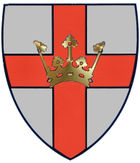Location: Peter-Altmeier-Ufer

Koblenz (also Coblenz in pre-1926 German spellings; French Coblence) is a city situated on both banks of the Rhine at its confluence with the Moselle, where the Deutsches Eck (German Corner) and its monument ( Emperor William I on horseback) are situated. 
As Koblenz (Latin (ad) Confluentes, "confluence" or "(at the) merging (rivers)", Covelenz, Cobelenz; local dialect "Kowwelenz") was one of the military posts established by Drusus about 8 B.C., the town celebrated its 2000th anniversary in 1992.
After Mainz and Ludwigshafen am Rhein, it's the third largest city in Rhineland-Palatinate (German Rheinland-Pfalz), Germany. Koblenz lies in the Rhineland, 92 kilometers (57 miles) southeast of Cologne by rail, the population grew from 31,669 (1885) and 53,902 (1905) to 107,064 (2005),
The German Order was given an area for their Deutschherrenhaus Balley right at the border of both rivers, which became known as German corner (Deutsches Eck).
In 1897, a monument to German Emperor Wilhelm I, mounted on a 14 meter high horse, was inaugurated there by his grandson Wilhelm II. The German corner is since associated with this monument, the united German Empire and the German refusal of any French claims to the area, as described in the song Wacht am Rhein.
During WW2, the statue was destroyed by US artillery. The French occupation administration intended the complete destruction of the monument and wanted to replace it with a new one.
In 1953, Bundespräsident Theodor Heuss re-dedicated the monument to German unity, adding the signs of the remaining western federal states as well as the ones of the lost areas in the East. A Flag of Germany waved there since. The Saarland was added four years later after the population had voted to join Germany.
In the 1980s, a movie of the monument was often shown on late night TV when the National Anthem was played to mark the end of the day, a practise which was discontinued when nonstop broadcasting became common. On October 3, 1990, the very day the former GDR states joined, their signs were added to the monument.
As German unity was considered complete and the areas under Polish administration were ceded to Poland, the monument lost its official active purpose, now only reminding of past history. In 1993, the flag was replaced by a copy of the statue, donated by a local couple.
Quelle: www.wikipedia.de
|
|

